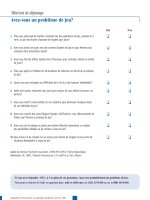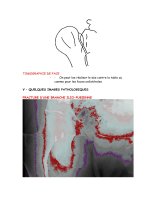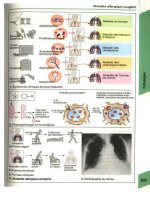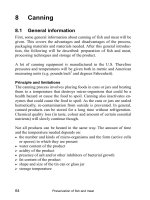Candida infections detection and epidemiology - part 8 potx
Bạn đang xem bản rút gọn của tài liệu. Xem và tải ngay bản đầy đủ của tài liệu tại đây (430.89 KB, 15 trang )
High levels of hydrolytic enzymes
96
Proteinase assay. One-hundred-and-eighty-five isolates were tested in de proteinase assay.
The number of isolates and the different scores are depicted in Table 5. In all but nine isolates
proteinase activity was detected (95%). Several isolates were tested in duplicate or triplicate,
and showed only minor differences (average difference between duplicate tests: 0.03). There
was no clear correlation between the results of the proteinase assay and the geographical
distribution of the isolates.
Of all isolates obtained from pneumonia that were tested in the proteinase assay (n = 23),
96% produced considerable amounts of proteinase (+ or ++), whereas for isolates obtained
from the other sources (blood (n = 131), the urinary tract (n = 24), or wound/sst (n = 7)) this
percentage was 80, 79, and 73% respectively (Table 6). However, this difference was not
statistically significant.
Table 5
Results of the proteinase assay
Score - +/- + ++
No. isolates (%) 9 (5) 25 (14) 118 (64) 33 (18)
Table 6
Results of the proteinase assay in relation with the site of infection
No. of isolates (%)
Source - +/- + ++ Total
blood 5 (4) 21 (16) 83 (63) 22 (17) 131 (100)
pneumonia 0 (0) 1 (4) 14 (61) 8 (35) 23 (100)
urinary tract 2 (8) 3 (13) 17 (71) 2 (8) 24 (100)
wound/s/st 2 (29) 0 (0) 4 (57) 1 (14) 7 (100)
wound/s/st: isolates originating from wounds, skin or soft tissue
DISCUSSION
Previous studies on the (phospho)lipase activity of C. albicans isolates reported a large
variation in activity among different isolates, but a remarkably constant degree of activity of
individual isolates which was fairly independent of inoculum size
10,14,16
. This is in agreement
with our results: the ratio of the diameter of the colony plus precipitation zone and the colony
alone ranged from 1.05 to 2.36 in the positive isolates, with an average difference between
duplicate tests of 0.08.
When looking at (phospho)lipase activity in relation to the site of infection, Price et al.
found that 55% of the blood isolates studied were positive in the assay
14
. These isolates were
also among the highest producers. Furthermore, 50% of the isolates cultured from wounds, and
30% of the isolates from the urinary tract were also positive. Our results show different
percentages: 71% of the blood isolates, 72% of the isolates from the urinary tract, and 29% of
the isolates from wound/skin/soft tissue were positive in the assay. However, whereas Price et
Chapter 8
97
al. examined substantially more wound isolates than we did (n = 28 versus n = 7), we tested
larger numbers of isolates from blood and the urinary tract (blood: n = 131 versus n = 11;
urinary tract: n = 25 versus n = 13). These differences may account for the different results.
In addition to the sources described above, we also examined strains which originated from
pneumonia. It appeared that this group showed the highest number of positive isolates in the
(phospho)lipase assay (87%, n = 23). Furthermore, 61% of these isolates were among the
higher producers (in comparison with the other sources: blood 37%; urinary tract 28%;
wound/skin/soft tissue 14%)(Table 4). Although not statistically significant, a similar trend
was observed for the proteinase assay: all isolates obtained from pneumonia were positive in
the proteinase assay, and 96% of these isolates were high producers (other sources: blood 80%;
urinary tract 79%; wound/skin/soft tissue 73%)(Table 6). According to fingerprinting data
obtained with amplified fragment length polymorphism analysis (AFLP) only two isolates
originating from pneumonia (from Genoa, Italy) were identical. The patterns of all other
pneumonia isolates showed clear differences (results not shown). Therefore, there is no bias
due to hospital outbreaks.
It is possible that our findings are related to earlier reports by Samaranayake et al. and
Kothavade and Panthaki which mention relatively high numbers of (phospho)lipase producers
among clinical oral C. albicans isolates (79% and 89% respectively)
10,16
. An exceptionally
high number of 78% of our pneumonia isolates were derived from patients in the intensive
care. For the three other sources this percentage was approximately 30% (Table 2). Albeit this
data is lacking, it seems legitimate to assume that many of these patients were mechanically
ventilated. In that case the C. albicans isolates causing the pneumonia may very well originate
from the patient's own oral cavity. It is interesting to note that whereas oral C. albicans isolates
from healthy volunteers show a relatively low phospholipase activity, clinical isolates from the
oral cavities of patients suffering from oral candidosis produce relatively high amounts of this
enzyme
9,10,16
. Furthermore, oral C. albicans isolates of HIV-positive individuals are known to
cause unusual severe infections. These isolates also produce extremely high amounts of
proteinases
3,13
. It is hypothesized that these infections are attributable to selection of
commensal C. albicans isolates which are characterized by a higher virulence. It is a tempting
idea that these more virulent isolates also have an increased potential of causing pneumonia in
intensive care patients. The underlying mechanisms behind the selection of these high virulent
strains are undetermined.
SAP production by C. albicans not only depends on strain type or type of infection, but also
on phenotypic switch type, environmental conditions, and even the stage of infection
4
.
Therefore, caution must be employed in the interpretation of proteinase assays. However,
although especially the proteinase assay is a crude screening method, it is noteworthy that the
results of both assays indicate a possible higher virulence for isolates involved in pneumonia.
Whether this is caused by selection of more virulent isolates which are part of the commensal
flora of the patients remains to be solved.
High levels of hydrolytic enzymes
98
A
CKNOWLEDGEMENTS
We would like to thank Christine Morrison for her advice on the proteinase assay.
Annemarie Borst is supported by a grant from bioMérieux (formerly Organon Teknika).
R
EFERENCES
1. Calderone, R.A. and W.A. Fonzi. 2001. Virulence factors of Candida albicans. Trends Microbiol. 9: 327-
335
2. De Bernardis, F., S. Arancia, L. Morelli, B. Hube, D. Sanglard, W. Schafer, and A. Cassone. 1999.
Evidence that members of the secretory aspartyl proteinase gene family, in particular SAP2, are virulence
factors for Candida vaginitis. J. Infect. Dis. 179: 201-208
3. De Bernardis, F., P. Chiani, M. Ciccozzi, G. Pellegrini, T. Ceddia, G. D'Offizzi, I. Quinti, P.A.
Sullivan, and A. Cassone. 1996. Elevated aspartic proteinase secretion and experimental pathogenicity of
Candida albicans isolates from oral cavities of subjects infected with human immunodeficiency virus. Infect.
Immun. 64: 466-471
4. De Bernardis, F., P.A. Sullivan, and A. Cassone. 2001. Aspartyl proteinases of Candida albicans and their
role in pathogenicity. Med. Mycol. 39: 303-313
5. Fu, Y., A.S. Ibrahim, W. Fonzi, X. Zhou, C.F. Ramos, and M.A. Ghannoum. 1997. Cloning and
characterization of a gene (LIP1) which encodes a lipase from the pathogenic yeast Candida albicans.
Microbiology 143 ( Pt 2): 331-340
6. Ghannoum, M.A. 2000. Potential role of phospholipases in virulence and fungal pathogenesis. Clin.
Microbiol. Rev. 13: 122-43
7. Hube, B., D. Sanglard, F.C. Odds, D. Hess, M. Monod, W. Schafer, A.J. Brown, and N.A. Gow. 1997.
Disruption of each of the secreted aspartyl proteinase genes SAP1, SAP2, and SAP3 of Candida albicans
attenuates virulence. Infect. Immun. 65: 3529-3538
8. Hube, B., F. Stehr, M. Bossenz, A. Mazur, M. Kretschmar, and W. Schafer. 2000. Secreted lipases of
Candida albicans: cloning, characterisation and expression analysis of a new gene family with at least ten
members. Arch. Microbiol. 174: 362-374
9. Ibrahim, A.S., F. Mirbod, S.G. Filler, Y. Banno, G.T. Cole, Y. Kitajima, J.E. Edwards, Jr., Y. Nozawa,
and M.A. Ghannoum. 1995. Evidence implicating phospholipase as a virulence factor of Candida albicans.
Infect. Immun. 63: 1993-1998
10. Kothavade, R.J. and M.H. Panthaki. 1998. Evaluation of phospholipase activity of Candida albicans and
its correlation with pathogenicity in mice. J. Med. Microbiol. 47: 99-102
11. Leidich, S.D., A.S. Ibrahim, Y. Fu, A. Koul, C. Jessup, J. Vitullo, W. Fonzi, F. Mirbod, S. Nakashima,
Y. Nozawa, and M.A. Ghannoum. 1998. Cloning and disruption of caPLB1, a phospholipase B gene
involved in the pathogenicity of Candida albicans. J. Biol. Chem. 273: 26078-26086
12. McLain, N. and J.W. Dolan. 1997. Phospholipase D activity is required for dimorphic transition in Candida
albicans. Microbiology 143 ( Pt 11): 3521-3526
13. Ollert, M.W., C. Wende, M. Gorlich, C.G. McMullan-Vogel, M. Borg-von Zepelin, C.W. Vogel, and
H.C. Korting. 1995. Increased expression of Candida albicans secretory proteinase, a putative virulence
Chapter 8
99
factor, in isolates from human immunodeficiency virus-positive patients. J. Clin. Microbiol. 33: 2543-2549
14. Price, M.F., I.D. Wilkinson, and L.O. Gentry. 1982. Plate method for detection of phospholipase activity
in Candida albicans. Sabouraudia. 20: 7-14
15. Pugh, D. and R.A. Cawson. 1975. The cytochemical localization of phospholipase a and lysophospholipase
in Candida albicans. Sabouraudia. 13 Pt 1: 110-115
16. Samaranayake, L.P., J.M. Raeside, and T.W. MacFarlane. 1984. Factors affecting the phospholipase
activity of Candida species in vitro. Sabouraudia. 22: 201-207
17. Sanglard, D., B. Hube, M. Monod, F.C. Odds, and N.A. Gow. 1997. A triple deletion of the secreted
aspartyl proteinase genes SAP4, SAP5, and SAP6 of Candida albicans causes attenuated virulence. Infect.
Immun. 65: 3539-3546
18. Watts, H.J., F.S. Cheah, B. Hube, D. Sanglard, and N.A. Gow. 1998. Altered adherence in strains of
Candida albicans harbouring null mutations in secreted aspartic proteinase genes. FEMS Microbiol. Lett.
159: 129-135
IX: AFLP typing of European Candida albicans isolates
shows geographical specificities
A. Borst
1
, B. Theelen
2
, T. Boekhout
2
, A.C. Fluit
1
1
Eijkman-Winkler Center, University Medical Center, Utrecht, the Netherlands
2
Centraalbureau voor Schimmelcultures, Utrecht, the Netherlands
Submitted for publication.
AFLP typing of European Candida albicans isolates
102
A
BSTRACT
Amplified Fragment Length Polymorphism (AFLP™) analysis was used to fingerprint a
large panel of European clinical C. albicans isolates obtained from the SENTRY antimicrobial
surveillance program, and the correlation between AFLP type and geographical origin of the
isolates, the site of infection, and the production of (phospho)lipases and proteinases was
studied. The isolates show a subdivision into two main clusters, cluster 1 and cluster 2. Isolates
from most countries can be found in both clusters. However, isolates from Spain and Portugal
(n = 49) are restricted to cluster 1, whereas isolates from the United Kingdom and Germany (n
= 27) seem restricted to cluster 2. The differences between the two clusters in relation to the
site of infection and the production of hydrolytic enzymes are probably due to sampling bias.
In conclusion: our results suggest the presence of a clone specific for the Iberian peninsula, and
possibly also a specific Northern European clone.
I
NTRODUCTION
Candida albicans is a commensal yeast which can cause severe infections in
immunocompromised individuals. Relatively little is known about the epidemiology of
Candida infections. Several typing methods have been used for Candida species, but none of
them is considered the golden standard
3,8,13-15,18
. Amplified Fragment Length Polymorphism
(AFLP™) analysis, first described by Vos et al. in 1995, has several advantages over other
fingerprinting methods
16,19
. The technique is based on the restriction of chromosomal DNA
and ligation of known sequences (adapters) to the restriction fragments, which serve as targets
for PCR amplification. Therefore, AFLP is universally applicable without the need to design
specific primers and probes. Depending on the organism under study, the primers are extended
with one or more selective nucleotides to increase the specificity. Since the primer binding
sites are known, stringent annealing temperatures can be used. This makes this technique more
reproducible compared to Randomly Amplified Polymorphic DNA (RAPD) analysis
10
.
Furthermore, only a limited amount of DNA is needed. This greatly reduces the risk of partial
digestion, a major source of irreproducibility with Restriction Fragment Length Polymorphism
(RFLP) analysis. Another difference with many other typing methods is that AFLP patterns are
a representation of the whole genome. The patterns can easily be stored in general accessible
databases, which may greatly facilitate the exchange of results between laboratories.
We have previously demonstrated the value of AFLP for the identification of different
Candida species
5
. In the present study, AFLP was used to fingerprint a large panel of European
clinical C. albicans isolates obtained from the SENTRY antimicrobial surveillance program.
Furthermore, we studied whether specific AFLP types of C. albicans correlated with the
geographical origin of the isolates, with the type of infection, and with the production of two
putative virulence factors, (phospho)lipases and proteinases
7,9
. Knowledge of such correlations
may help to understand the epidemiology of C. albicans infections, which may result in
improved therapeutic regimens.
Chapter 9
103
M
ATERIALS AND METHODS
Yeast strains. Candida albicans isolates were obtained from the European SENTRY
Program. Only one isolate per patient was included. A total number of 189 isolates derived
from 19 medical centers in 12 European countries were studied. One-hundred-and-thirty-two
isolates (70%) originated from infections from blood, 6 (3%) from wounds/skin/soft tissue, 26
(14%) from the urinary tract, and 25 (13%) from pneumonia. Most isolates were derived from
the intensive care (37%), internal medicine (15%), surgery (13%), pediatrics (11%) or
oncology (6%). Identification of the isolates was performed using CHROMagar plates
(CHROMagar, Paris, France). The isolates were cultured on Blood Agar and subcultured on
Sabouraud Dextrose Agar (SDA) at 37°C.
Extraction of DNA. DNA was extracted from approximately 10
7
cfu C. albicans using the
DNeasy Tissue kit (Qiagen, West Sussex, England) according to the manufacturer (protocol
for isolation of genomic DNA from yeasts). DNA was eluted in 100 µl elution buffer (buffer
AE of the kit) and stored at -20°C.
AFLP. The sequences of the adapters and primers used for AFLP are depicted in Table 1.
DNA was extracted from approximately 10
7
cfu C. albicans as described above. Five µl of the
DNA samples were added to 5 µl restriction-ligation reaction mixture (1x T
4
DNA ligase
buffer; 0.05 M NaCl; 0.5 µg BSA; 2 pmol EcoRI-adapter; 20 pmol MseI-adapter; 80 U T
4
DNA ligase; 1 U EcoRI; 1 U MseI, and incubated over night at 37°C. All enzymes were
obtained from New England BioLabs (Beverly, USA). The mixture was diluted 1:5 with 0.1x
TE (5 mM Tris-HCl (pH 7.5); 1 mM EDTA). Pre-selective PCR was performed using the core
sequences, i.e. primers without extensions. The AFLP primers, core mix, and internal size
standard were supplied by Applied Biosystems (Nieuwerkerk a/d IJssel, the Netherlands). Four
µl of diluted restriction-ligation product was added to 15 µl of AFLP amplification core mix,
0.5 µl EcoRI core sequence and 0.5 µl MseI core sequence. The mixture was amplified in a
GeneAmp
®
PCR System 9700 machine under the following conditions: 2 min. at 72°C,
followed by 20 cycles of 20 sec. at 94°C, 30 sec. at 56°C and 2 min. at 72°C each. The PCR
product was diluted by adding 25 µl sterile double distilled water. In a second PCR reaction
more selective primers were used: EcoRI-AC (FAM-labeled) and MseI-C. The conditions
were: 2 min. at 94°C, followed by 10 cycles consisting of 20 sec. at 94°C, 30 sec. at 66°C
decreasing 1°C every step of the cycle, and 2 min. at 72°C, followed by 25 cycles consisting of
20 sec. at 94°C, 30 sec. at 56°C and 2 min. at 72°C. After a final incubation of 30 min. at
60°C the samples were prepared for capillary electrophoresis by adding 2 µl of the selective
PCR product to 24 µl of deionized formamide and 1 µl of GeneScan-500 (ROX-labeled) as an
internal size standard. They were run on the ABI 310 Genetic Analyzer for 30 min. each. Data
were analyzed with the BioNumerics software package, version 2.5 (Applied Maths, Sint-
Martens-Latem, Belgium) using the Pearson correlation as a similarity coefficient in
combination with Unweighted Pair Group Method with Arithmatic Mean (UPGMA) cluster
analysis.
(Phospho)lipase assay. (Phospho)lipase activity of the isolates was determined by using
the egg yolk agar plate assay developed by Price et al. as described before
4,12
. The activity was
determined by the ratio of the diameter of the colony plus precipitation zone to the diameter of
the colony alone. The isolates were classified as 'low producers' (ratio < 1.50) or 'high
AFLP typing of European Candida albicans isolates
104
producers' (ratio ≥ 1.50).
Proteinase assay. Proteinase activity of the isolates was determined by using agar plates
supplemented with bovine serum albumin (BSA) as described before
4
. The activity was
determined by the ratio of the diameter of the clear zone to the diameter of the colony. The
isolates were classified as 'low producers' (ratio < 0.9) or 'high producers' (ratio ≥ 0.9).
Table 1
The adapter- and primer-sequences used for AFLP
Adapter Sequence
EcoRI 5'-CTCGTAGACTGCGTACC-3'
3'-CATCTGACGCATGGTTAA-5'
MseI 5'-GACGATGAGTCCTGAG-3'
3'-CTACTCAGGACTCAT-5'
Primer Sequence
1
EcoRI 5'-GACTGCGTACCAATTCAC-3'
MseI 5'-GATGAGTCCTGAGTAAC-3'
1
bold: selective nucleotides (used only in the second PCR reaction)
RESULTS
A dendogram representing 50% of the results of the AFLP analysis, the (phospho)lipase
assay, and the proteinase assay is shown in Figure 1. The complete dendogram can be obtained
from the corresponding author. Identical isolates (similarity > 90%, based on duplicate testing)
were found within one hospital as well as in different countries. The isolates show two main
clusters, 1 and 2, and a few miscellaneous types (cophenetic values: cluster 1: 76; cluster 2:
72). Cluster 1 contains isolates from France (n = 5), Germany (n = 1), Italy (n = 16), the
Netherlands (n = 6), Poland (n = 1), Portugal (n = 23), Spain (n = 26), Switzerland (n = 7), and
Turkey (n = 4). Cluster 2 contains isolates from Austria (n = 3), France (n = 10), Germany (n =
15), Greece (n = 3), Italy (n = 25), Switzerland (n = 6), the United Kingdom (n = 11), and
Turkey (n = 20). There is no correlation between AFLP type and hospital ward (results not
shown). The relation between the clusters and the site of infection is depicted in Table 2.
Cluster 1 contains significantly more isolates from infections of the urinary tract compared to
cluster 2, whereas cluster 2 contains significantly more isolates from pneumonia compared to
cluster 1 (p = 0.001, Pearson chi-square test (exact)).
Table 2
The relation between the AFLP clusters and the site of infection
No. of isolates (%)
cluster blood pneumonia urinary tract wound/skin/soft tissue
1 64 (74) 4 (5) 17 (20) 1 (1)
2 65 (69) 18 (19) 7 (7) 4 (4)
Chapter 9
105
n.d. n.d.
L L
L L
H L
H L
H L
H L
L L
n.d. L
H L
H L
L H
H L
H L
H L
n.d. n.d.
L L
H L
L L
H H
H H
H H
L H
n.d. n.d.
H H
L L
H L
H L
H H
H L
H L
H L
n.d. n.d.
L L
L L
H L
H L
H L
L L
n.d. n.d.
L H
H H
H L
H L
H H
H H
H H
H L
H L
H H
H H
H H
H H
H H
H H
L L
H H
H H
H H
H L
H L
H H
L H
H L
n.d. n.d.
H L
L L
H H
H L
H H
H H
H L
H L
H L
L L
H L
L L
H H
H H
H H
H H
L H
H L
H H
H H
H H
H L
H L
H L
H L
H H
H H
H L
H L
Isolate
1
: P
2
: PL
2
:
100
95
90
85
80
75
70
65
60
55
16A107
16A232
15A020
15A237
10A343
11A384
16E014
16A551
16E026
17A381
12E070
12E036
10A139
12A103
11A182
18E014
23D046
16E033
18A220
16C067
15A257
13A145
15A093
10A138
11C034
06A267
19A298
16E050
15A375
15E106
16A308
06A063
15A629
15A647
19A355
15A206
15A561
17A184
11A301
16C088
19A260
20C108
20C147
01A120
20C110
07C073
08A240
07C060
07A524
10C021
20A156
19A568
10A506
10A570
10A535
09A263
23E055
23A080
19A566
04A080
07C045
07A301
23E003
07C066
23A005
23A078
07A621
06A125
06A309
04A360
06A154
24A028
04A122
08E058
08A573
09A437
23E095
08A424
10C007
11A134
10C026
10A144
10A555
10A600
20C072
11A219
06A038
15D013
10A614
16C081
16A380
15A160
17A462
24E007
Cluster 1
Cluster 2
AFLP typing of European Candida albicans isolates
106
Figure 1 (previous page)
Dendogram representing 50% of all C. albicans isolates studied
1
Isolate codes starting with '01' are derived from Linz (Austria); 04: Paris (France); 06: Lille (France); 07:
Freiburg (Germany); 08: Dusseldorf (Germany); 09: Athens (Greece); 10: Genoa (Italy); 11: Roma (Italy); 12:
Utrecht (the Netherlands); 13: Warsaw (Poland); 15: Coimbra (Portugal); 16: Sevilla (Spain); 17: Madrid
(Spain); 18: Barcelona (Spain); 19: Lausanne (Switzerland); 20: London (United Kingdom); 23: Ankara
(Turkey); 24: Istanbul (Turkey).
Isolates with an 'A' in the code are derived from blood; C: pneumonia; D: wound/skin/soft tissue; E: urinary
tract
2
P: proteinase; PL: (phospho)lipase; H: high producer; L: low producer; n.d.: no data
The relation between the clusters and the production of hydrolytic enzymes is depicted in
Table 3. Significantly more isolates in cluster 2 were among the high producers of
(phospho)lipases and proteinases compared to the isolates in cluster 1 (p = 0.001 and p = 0.025
respectively, Pearson chi-square test (exact)).
Table 3
The relation between the AFLP clusters and production of hydrolytic enzymes
(Phospho)lipase Proteinase
cluster low high low high
1 59 (76) 19 (24) 20 (26) 57 (74)
2 44 (49) 45 (51) 10 (11) 78 (89)
No. of isolates (%)
DISCUSSION
Strain typing is important in various situations, e.g. to find the source of a hospital outbreak
or to elucidate the relationship between commensal and infecting strains. Furthermore, strain
typing is essential to study the dynamics of a microorganism in a human population. Linking
genotypic fingerprinting data to data on the geographic origin of certain isolates, the site of
infection, or the expression of virulence factors will improve our understanding of the
epidemiology of Candida infections. Furthermore, because Candida albicans reproduction is
predominantly clonal, it may be the first step in identifying genetic markers for specific traits, a
process which ultimately may lead to improved therapeutic regimens.
When we only take into account the countries of which ten or more isolates were studied,
there seems to be a division between countries represented exclusively in cluster 1 (Portugal,
Spain), countries represented exclusively (United Kingdom) or almost exclusively (Germany)
in cluster 2, and countries of which the isolates are represented more or less equally in both
clusters (France, Italy, Switzerland, Turkey). The possibility that our results demonstrate the
presence of separate 'Iberian' and 'Northern-European' C. albicans clones which coexist in
Central-European countries is appealing. Clemons et al. showed that 86 clinical isolates from
three medical centers in the United Kingdom and six medical centers in the United States form
two clusters, IA and IB, when typed by restriction endonuclease analysis using EcoRI
6
. We
Chapter 9
107
examined 11 isolated from one medical center in the United Kingdom. Our results implying a
clone specific for Northern Europe may be biased by the limited number of isolates and
medical centers studied. Clusters IA and IB may correspond with the AFLP clusters 1 and 2.
However, it is also possible that a third cluster exists, which is as yet undiscovered by AFLP.
Forty-nine isolates from four medical centers throughout Spain and Portugal were included in
our experiments, and none of them was found in cluster 2. Therefore, the existence of an
Iberian clone is more convincing.
The finding that cluster 1 contains significantly more isolates from infections of the urinary
tract compared to cluster 2 (Table 2) can at least in part be explained by the relatively large
number of urinary tract-derived isolates obtained from Portugal and Spain. The same holds
true for the abundance of pneumonia-derived isolates in cluster 2: the isolates obtained from
the Germany and the United Kingdom show relatively high numbers of isolates from this
source. Whether there is an additional explanation for this relation between AFLP cluster and
site of infection remains to be solved.
Cluster 2 contains significantly more isolates which produce high amounts of
(phospho)lipases and/or proteinases, both putative virulence factors of C. albicans (Table 3).
We have shown previously that pneumonia-derived isolates show a relatively high production
of hydrolytic enzymes
4
. Compared to cluster 1, cluster 2 contains a relatively high number of
isolates which originate from pneumonia (Table 2). This may account for the difference in
production of these hydrolytic enzymes between isolates in the two groups.
The results of several typing methods for C. albicans, such as RAPD, multilocus enzyme
electrophoresis (MLEE), and Southern blot hybridization with the moderately repetitive C.
albicans specific Ca3 probe, show a good agreement
13
. To validate the results of AFLP typing,
the technique should be compared with at least one of these other typing methods, using the
same collection of isolates. However, AFLP typing has been used successfully for many
organisms including Saccharomyces cerevisiae, a close relative of C. albicans
1,16,19
.
Geographical specificities of certain C. albicans strains have been demonstrated before for
isolates from South-Africa, Singapore, and the North-Eastern United States
2,11,17
. Our results
suggest the presence of a clone specific for the Iberian peninsula, and possibly also a specific
Northern European clone.
A
CKNOWLEDGEMENTS
We would like to thank Paul Savelkoul for technical advice.
Annemarie Borst is supported by a grant from bioMérieux (formerly Organon Teknika).
R
EFERENCES
1. Azumi, M. and N. Goto-Yamamoto. 2001. AFLP analysis of type strains and laboratory and industrial
strains of Saccharomyces sensu stricto and its application to phenetic clustering. Yeast 18: 1145-1154
AFLP typing of European Candida albicans isolates
108
2. Blignaut, E., C. Pujol, S. Lockhart, S. Joly, and D.R. Soll. 2002. Ca3 Fingerprinting of Candida albicans
Isolates from Human Immunodeficiency Virus-Positive and Healthy Individuals Reveals a New Clade in
South Africa. J. Clin. Microbiol. 40: 826-836
3. Boerlin, P., F. Boerlin-Petzold, J. Goudet, C. Durussel, J.L. Pagani, J.P. Chave, and J. Bille. 1996.
Typing Candida albicans oral isolates from human immunodeficiency virus-infected patients by multilocus
enzyme electrophoresis and DNA fingerprinting. J. Clin. Microbiol. 34: 1235-1248
4. Borst, A., and A.C. Fluit. 2002. High levels of hydrolytic enzymes secreted by Candida albicans isolates
involved in pneumonia. Submitted for publication.
5. Borst, A., B. Theelen, E. Reinders, T. Boekhout, A.C. Fluit, and P.H. Savelkoul. 2002. AFLP as an
identification method for medically important Candida spp., including C. dubliniensis. Submitted for
publication.
6. Clemons, K.V., F. Feroze, K. Holmberg, and D.A. Stevens. 1997. Comparative analysis of genetic
variability among Candida albicans isolates from different geographic locales by three genotypic methods. J.
Clin. Microbiol. 35: 1332-1336
7. De Bernardis, F., P.A. Sullivan, and A. Cassone. 2001. Aspartyl proteinases of Candida albicans and their
role in pathogenicity. Med. Mycol. 39: 303-313
8. Diaz-Guerra, T.M., J.V. Martinez-Suarez, F. Laguna, and J.L. Rodriguez-Tudela. 1997. Comparison of
four molecular typing methods for evaluating genetic diversity among Candida albicans isolates from human
immunodeficiency virus-positive patients with oral candidiasis. J. Clin. Microbiol. 35: 856-861
9. Ghannoum, M.A. 2000. Potential role of phospholipases in virulence and fungal pathogenesis. Clin.
Microbiol. Rev. 13: 122-43, table
10. Jones, C.J., K.J. Edwards, S. Castaglione, M.O. Winfield, F. Sala, C. VandeWiel, G. Bredemeijer, B.
Vosman, M. Matthes, A. Daly, R. Brettschneider, P. Bettini, M. Buiatti, E. Maestri, A. Malcevschi, N.
Marmiroli, R. Aert, G. Volckaert, J. Rueda, R. Linacero, A. Vazquez, and A. Karp. 1997.
Reproducibility testing of RAPD, AFLP and SSR markers in plants by a network of European laboratories.
Molecular Breeding 3: 381-390
11. Pfaller, M.A., S.R. Lockhart, C. Pujol, J.A. Swails-Wenger, S.A. Messer, M.B. Edmond, R.N. Jones,
R.P. Wenzel, and D.R. Soll. 1998. Hospital specificity, region specificity, and fluconazole resistance of
Candida albicans bloodstream isolates. J. Clin. Microbiol. 36: 1518-1529
12. Price, M.F., I.D. Wilkinson, and L.O. Gentry. 1982. Plate method for detection of phospholipase activity
in Candida albicans. Sabouraudia. 20: 7-14
13. Pujol, C., S. Joly, S.R. Lockhart, S. Noel, M. Tibayrenc, and D.R. Soll. 1997. Parity among the randomly
amplified polymorphic DNA method, multilocus enzyme electrophoresis, and Southern blot hybridization
with the moderately repetitive DNA probe Ca3 for fingerprinting Candida albicans. J. Clin. Microbiol. 35:
2348-2358
14. Robert, F., F. Lebreton, M.E. Bougnoux, A. Paugam, D. Wassermann, M. Schlotterer, C. Tourte-
Schaefer, and J. Dupouy-Camet. 1995. Use of random amplified polymorphic DNA as a typing method for
Candida albicans in epidemiological surveillance of a burn unit. J. Clin. Microbiol. 33: 2366-2371
15. Sadhu, C., M.J. McEachern, E.P. Rustchenko-Bulgac, J. Schmid, D.R. Soll, and J.B. Hicks. 1991.
Telomeric and dispersed repeat sequences in Candida yeasts and their use in strain identification. J.
Bacteriol. 173: 842-850
16. Savelkoul, P.H., H.J. Aarts, J. de Haas, L. Dijkshoorn, B. Duim, M. Otsen, J.L. Rademaker, L.
Schouls, and J.A. Lenstra. 1999. Amplified-fragment length polymorphism analysis: the state of an art. J.
Clin. Microbiol. 37: 3083-3091
Chapter 9
109
17. Schmid, J., S. Herd, P.R. Hunter, R.D. Cannon, M.S. Yasin, S. Samad, M. Carr, D. Parr, W.
McKinney, M. Schousboe, B. Harris, R. Ikram, M. Harris, A. Restrepo, G. Hoyos, and K.P. Singh.
1999. Evidence for a general-purpose genotype in Candida albicans, highly prevalent in multiple
geographical regions, patient types and types of infection. Microbiology 145 ( Pt 9): 2405-2413
18. Thanos, M., G. Schonian, W. Meyer, C. Schweynoch, Y. Graser, T.G. Mitchell, W. Presber, and H.J.
Tietz. 1996. Rapid identification of Candida species by DNA fingerprinting with PCR. J. Clin. Microbiol.
34: 615-621
19. Vos, P., R. Hogers, M. Bleeker, M. Reijans, T. Van de Lee, M. Hornes, A. Frijters, J. Pot, J. Peleman,
M. Kuiper, and M. Zabeau. 1995. AFLP: a new technique for DNA fingerprinting. Nucleic Acids Res. 23:
4407-4414









